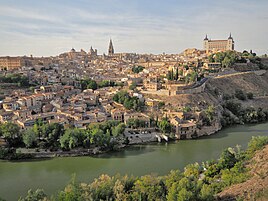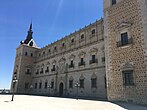
Back Toledo Afrikaans Toledo ALS ቶሌዶ Amharic Toledo AN طليطلة Arabic توليدو ARZ Toledo AST Toledo Azerbaijani تولدو AZB Таледа Byelorussian
Toledo | |
|---|---|
| Nickname(s): La ciudad imperial (The Imperial City) and Ciudad de las Tres Culturas (City of the Three Cultures) | |
 Location of Toledo | |
| Coordinates: 39°51′24″N 4°1′28″W / 39.85667°N 4.02444°W | |
| Country | Spain |
| Autonomous Community | Castilla–La Mancha |
| Province | Toledo |
| Settled | Pre-Roman |
| Government | |
| • Mayor | Carlos Velázquez (PP) |
| Area | |
| • Land | 232.1 km2 (89.6 sq mi) |
| Elevation | 529 m (1,736 ft) |
| Population (2018)[2] | |
• Total | 85,085[1] |
| • Density | 359.58/km2 (931.3/sq mi) |
| Postcodes | 45001–45009 |
| Area code | +34 925 |
| Website | toledo |
| Official name | Historic City of Toledo |
| Criteria | Cultural: i, ii, iii, iv |
| Reference | 379 |
| Inscription | 1986 (10th Session) |
| Area | 259.85 ha |
| Buffer zone | 7,669.28 ha |
Toledo (UK: /tɒˈleɪdoʊ/ tol-AY-doh;[3] Spanish: [toˈleðo] ⓘ) is a city and municipality of Spain, the capital of the province of Toledo and the de jure seat of the government and parliament of the autonomous community of Castilla–La Mancha.
Toledo is primarily located on the right (north) bank of the Tagus in central Iberia, nestled in a bend of the river. It is known as the "City of the Three Cultures" for the cultural influences of Christians, Muslims, and Jews throughout its history. It was the capital, from 542 to 725 CE, of the Visigothic kingdom and was the venue for the Councils of Toledo. The city, seat of a powerful archdiocese for much of its history, has a Gothic Cathedral, and a long history in the production of bladed weapons, which are now common souvenirs of the city. Toledo was declared a World Heritage Site by UNESCO in 1986 for its extensive monumental and cultural heritage.
As of 2015[update], the municipality had a population of 83,226.[4] The municipality has an area of 232.1 km2 (89.6 sq mi).
- ^ "Toledo: Población por municipios y sexo. (2902)". Instituto Nacional de Estadística. 2022. Retrieved 20 March 2023.
- ^ Municipal Register of Spain 2018. National Statistics Institute.
- ^ "Toledo". Collins English Dictionary. HarperCollins. Retrieved 14 April 2019.
- ^ "Tabla2902". www.ine.es. Retrieved 2016-03-01.




